While brushing down their pet spaniel following a long summer walk, the owners discovered a pale grey lump hanging from its head just below its eye. This was an engorged and deeply embedded feeding tick; the mouthparts were firmly attached and not visibly obvious as they were deeply buried into the skin, but the tick's swollen abdomen was clearly exposed (Figure 1). The worried owner consulted their local veterinary surgery for advice. There is good evidence that ticks are becoming both more abundant and more widespread (Scharlemann et al, 2008). The number of pets being affected is increasing and the number of animals appearing in the veterinary surgery carrying ticks is likely to grow.
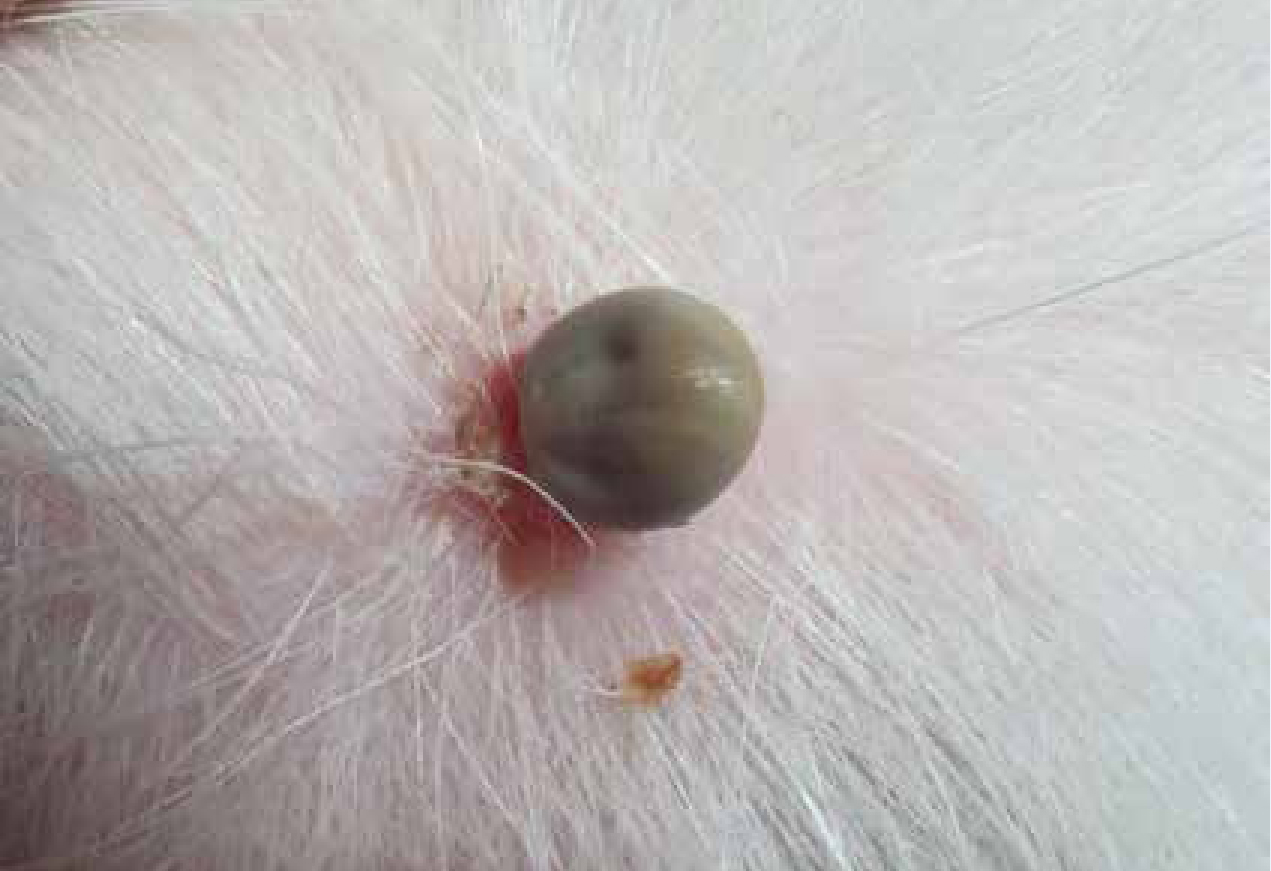
What are ticks?
Ticks are blood feeding parasites. Their exact classification is debated but they are usually placed within their own superorder (Parasitiformes) and order (Metastigmata/Ixodida) within the class Arachnida and subclass Acari (Baker, 1999; Beccaloni, 2009). Ticks are superbly adapted anatomically to their parasitic lifestyle. The standard ‘classic’ physical description is that provided by Arthur (1963); more recent descriptions are provided by Sonnenshine (1991) and Hillyard (1996). Their flattened body allows them to nestle easily between fur directly to the skin. The four pairs of legs often have sharp hooks on their inner sides, ‘spurs’, which aid attachment to the host. Ticks have a small hardened shield, the ‘scutum’, which in males covers the entire dorsal side. Females have a smaller scutum, thus allowing the body to expand more easily. Females take much larger blood meals than males. The mouthparts are highly specialised; sensory ‘palps’ feel for a suitable bite location, scissor like ‘chelicerae’ make the initial cut, and a sharp needle like tube, the ‘hypostome’, sucks up the blood (Richter et al, 2013).
The tick life cycle involves eggs hatching into larval ticks which have three leg pairs, these then moult into sexually immature nymphs, which in turn develop into sexually mature adults (Figure 2)(Beccaloni, 2009). Nymphs and adults have four pairs of legs. Adult ticks mate on the host, then females lay eggs in dense vegetation. Larval and nymphal ticks must feed to progress to the next life stage, while adult females must feed in order to produce eggs. Ticks have special sensory cells on their front legs known as the ‘Haller's Organ’ which can detect host heat and carbon dioxide. Ticks wait for hosts with outstretched front legs in a behaviour known as ‘questing’. In the wild larvae parasitise small rodents; while nymphs and adults select larger mammals such as deer or sheep. Pets and humans are accidental hosts.
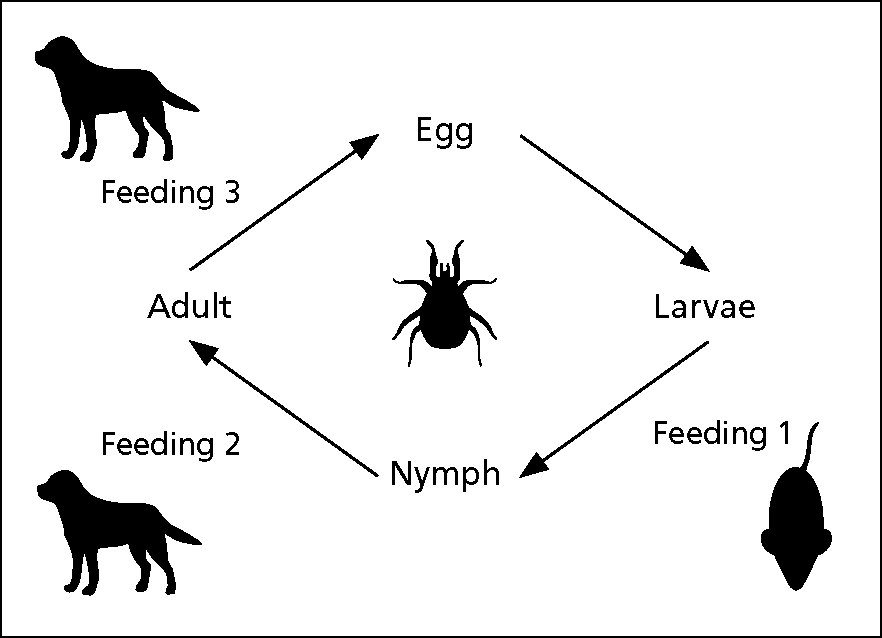
Important ticks
There are 24 different species of tick in the UK (Natural History Museum (NHM), 2017). Most are rarely seen because they are highly specialised and parasitise only certain host groups. The seabird tick (Ixodes uriae), for example, is found exclusively on marine dwelling birds, the rabbit tick (Ixodes ventalloi) mostly on small mammals. Others however have more generalist tastes feeding on a much larger range of hosts. The generalist sheep tick, or castor bean tick, (Ixodes ricinus) (Figures 3 and 4) parasitises a large range of mammals and birds making it the most common tick in the UK, and thus the most likely to be found on pets. Ixodes ricinus has a rounded tear-drop shape and reddish brown colouration (Hillyard, 1996). Unfed adult males are typically 2.5 to 3 mm in size, females are slightly larger being 3 to 5 mm (Beccaloni, 2009). However, when fed females become much larger, the abdomen becoming grossly engorged and taking on a pale greyish colour. Adult Ixodes ricinus remove 0.5 ml blood from the host in a feeding with engorged females being over 1 cm in size (Koch and Sauer, 1984). Larvae and nymphs are much smaller than adults, being only a few millimetres in size.
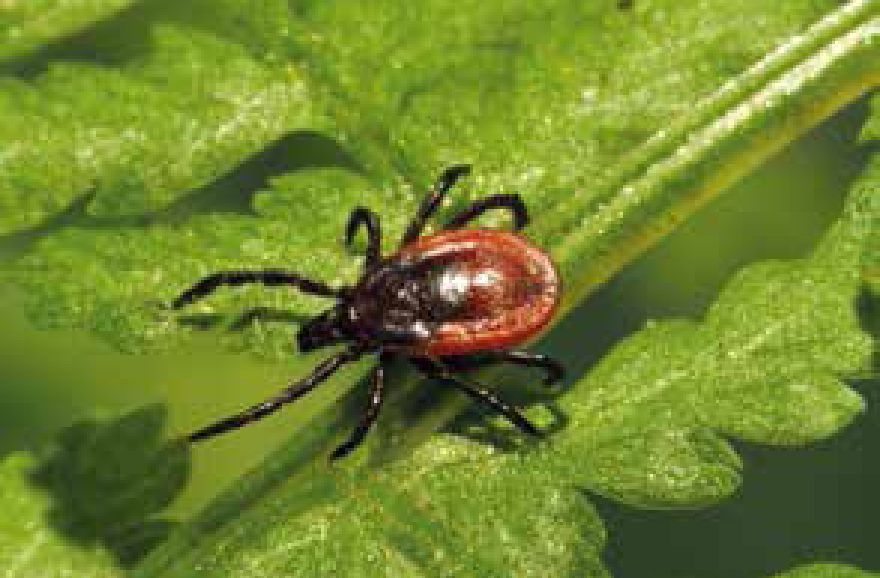
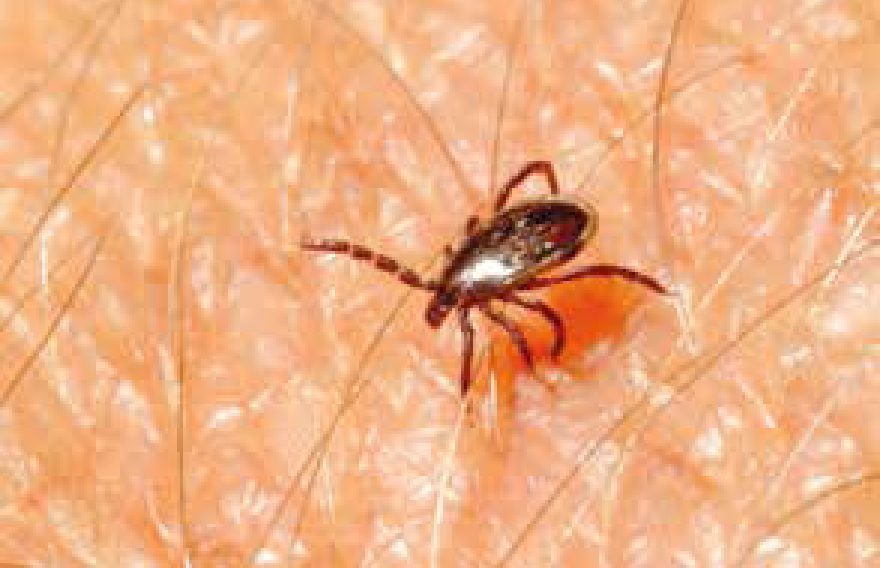
Another common tick seen on dogs and cats is the hedgehog tick (Ixodes hexagonus) (Figure 5), whose main host is the hedgehog (Erinaceus europaeus). The scutum is hexagonal, the mouthparts short and the leg tip humped. Another tick sometimes seen on domestic pets is the dog tick (Ixodes canisuga), whose hard cuticle allows it to withstand desiccation, thus it is often seen in kennelled dogs. A rarer tick is the meadow or marsh tick (Dermacentor reticulatus), which is found in western Wales, north and south Devon and Essex. This tick is the main vector of the disease babesiosis and has caused cases in the south east (Abdullah et al, 2017; Medlock et al, 2017). Another even rarer tick is the brown dog tick (Rhipicephalus sanguineus) which is not native to the UK, but is sometimes seen on kennelled animals brought into this country from abroad. Species identification can be difficult; and is often not needed in a veterinary setting. The Bristol University Tick Identification website is a good resource if identification is felt necessary.
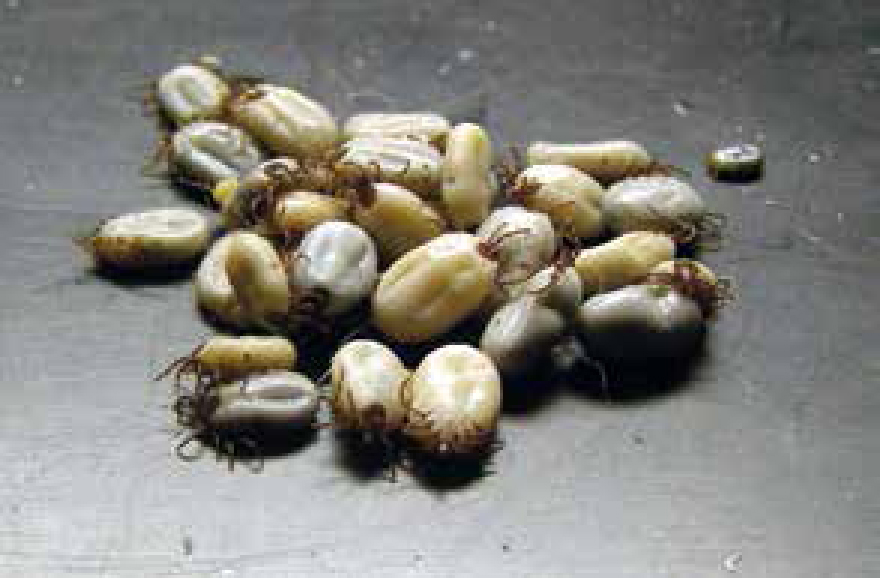
Recent research examined 12 096 dogs at veterinary surgeons across the UK (Abdullah et al, 2016). 5872 (48.5%) carried endemic ticks; most were Ixodes ricinus (89%), with some being Ixodes hexagonus (9.8%) and Ixodes canisuga (0.78%). Other species were seen only in small numbers. Another UK based study examined 3534 dogs, finding 810 (22.9%) with ticks; most being Ixodes ricinus (72.1%), and also Ixodes hexagonus (21.7%) and Ixodes canisuga (5.6%) (Smith et al, 2011).
Ticks appear to be becoming more common. Landowner surveying suggests a 17% increase in distribution and 73% increase in abundance over a 19 year time frame (Scharlemann et al, 2008). Examination of submitted records shows a similar increase in range from 2005 to 2009 (Jameson and Medlock, 2011). Why are ticks spreading? Deer which disperse ticks are becoming more widespread (Walker, 2015). Dense thick undergrowth is increasing due to agricultural changes (Medlock et al, 2013). Plus climate change is aiding tick survival; winters are becoming warmer meaning ticks are active longer, causing a shift in tick population peaks to autumn (Gray et al, 2009). Dermacentor reticulatus which is one of the main vectors of canine babesiosis is now well established in the south east, and likely to spread even further north and eastwards (Medlock et al, 2017).
Recognising and removing ticks
Attached ticks are often felt as small lumps between the fur of affected animals. Dogs will often collect ticks during a countryside walk, cats by curiously examining garden nests and thickets. Pets are often bitten on the head and neck; possibly because of their inquisitive nature. They are also often found on the ventral abdomen and axilla. With closer examination the tick can be more readily identified.
Embedded ticks should be removed promptly. Common household tweezers with a fine tip, not a blunt end can be used. The head parts should be held firmly and the tick removed with a quick straight upwards pull. If using special tick hooks then the tick can be removed with a upwards twisting movement. If possible do not squeeze as this may insert pathogenic saliva into the bloodstream and increase the risk of infection. Commercially available tick removers can be used; tick hooks are shaped so that they may lessen the risk of squeezing ticks. After removal the area can be cleaned with antiseptic to prevent infection. Although the general area may become red and inflamed, even with the application of antiseptics, this will recede with time. No further action should be required by the pet owner unless the pet develops symptoms of illness.
Veterinary nurses may encounter other less conventional suggestions regarding tick removal which they should be prepared to counter. Some recommend soaking ticks in alcohol to kill them instead of immediate removal. Others suggest covering ticks with cream thus suffocating them by covering the breathing pores. An ‘Indiana Jones’ suggestion is burning ticks off with lighters! Many fear leaving tick mouthparts embedded as this may lead to infection. However, the consensus is that ticks should be removed as quickly as possible as this reduces the time infectious agents have to invade hosts. These alternative methods may stress ticks which may then regurgitate pathogens into the host greatly increasing the risk of infection.
Diseases spread by ticks
Ticks themselves rarely cause direct problems to affected animals; although they remove blood the amount taken by a single tick is insignificant. Some wild animals can be infected with large numbers of ticks and this can cause substantial blood loss and subsequent anaemia. However for domestic pets ticks are more a nuisance. Ticks can transmit a range of diseases to both pets and humans. Before feeding, ticks pump saliva into the host; this contains anticoagulants and immune system suppressing substances making it easier for the tick to feed (Nuttall and Labuda, 2004). However, this saliva can also contain pathogens which the tick also inadvertently transmits. Table 1 lists the main diseases, these include babesiosis, ehrlichiosis and borreliosis (the causative agent of Lyme disease). Other rarer illnesses include Rocky Mountain Spotted Fever (Rickettsia conorii) and Q-fever (Coxiella burnetii).
| Common Name | Canine babesiosis | Rickettisal diseases (anaplasmosis and ehrlichiosis) | Borreliosis (Lyme disease) |
|---|---|---|---|
| Examples | Babesia venatorum | Ehrlichia canis | Borrelia burgdorferi |
| Vector | Dermacentor spp. | Rhicephalus spp. | Ixodes spp. |
| Pathogen Type | Protozoa (single celled parasites) | Bacterial | Bacterial |
| Attacks | Red blood cells | White blood cells, platelets in Anaplasma | Body organs/systemic |
| Symptoms |
|
|
|
| Diagnosis | Large forms can be seen on blood smears (Wright's stain). Otherwise polymerase chain reaction (PCR) required | Blood testing reveals decrease in platelet numbers. Also immunofluorescence assay (IFA) or PCR | Serologic test for antibodies, e.g. Idexx Snap4dx test |
| Treatment | Imidocarb diproprionate, e.g. Imizol 85 mg/ml Solution for Injection by Intervet (prescribed under the cascade) | Carbesia, better for dogs but not lincensed in UK. Antibiotic treatment with doxycycline (5 to 10 mg/kg per os (PO) for up to 24 days), or minocycline or tetracycline | Antibiotics: doxycycline (10 mg/kg PO for 4 weeks) |
Although these diseases appear not to be particularly common, they are widespread. Research by Smith and Wall (2013) using 677 ticks collected from dogs, found five ticks (0.74%) had Anaplasma phagocytophilum, and 16 (2.4%) had Babesia spp.. Recent research examining 4737 ticks from dogs has found Borrelia burgdorferi s.l. in 94 ticks (2%), and Babesia spp. in 70 ticks (1.5%) (Abdullah et al, 2017). Notable is that these pathogens were widespread throughout the UK. Babesiosis was first reported in the UK in 2006; outbreaks have occurred in the south east. Cases were reported in Essex in 2015, and have also occurred in Romford in west London and Harlow in Hertfordshire. Dermacentor ticks are the main vectors of Babesia, and as this species spreads so the cases of babesiosis will likely increase.
All these conditions cause similar non-specific symptoms: listlessness, fever, and a loss of appetite. They are often difficult to diagnose, requiring specialist blood tests or polymerase chain reaction (PCR) tests. Plus the symptoms only develop some time, typically weeks or months, after a tick bite. Careful questioning on the part of the veterinary nurse as to whether pets have travelled to infected regions in the recent past are useful in correct diagnosis. Conditions resulting from pathogen transmission via tick bite are often misdiagnosed. However, it must be remembered that often even if infected, pets may not develop clinical symptoms, merely carry the disease with no ill effect.
Risk factors
Rather obviously pets that rarely go outside have a much reduced chance of encountering ticks. Dogs taken frequently into countryside where ticks are known to occur are at an increased risk. Ticks are sensitive to drying out, thus are most prevalent in areas of dense vegetation and woodland edges which offer protection. However, urban living pets are not immune; city parks can also be a source of ticks (Jennet et al, 2013). Pets are most likely to be bitten by ticks in the summer months as this is when ticks are most active, but are at danger of being bitten all year round. Tick activity is related to temperature; ticks become active in early spring when temperatures rise above 7°C. The number of ticks on dogs has been found to be highest in June and lowest in March (Smith et al, 2011). Long haired dogs are at greater risk of having a tick than shorter haired breeds. Similarly those breeds that are most likely to rummage in thick vegetation, such as gun dogs, terriers and pastoral dogs are more likely to suffer tick bites (Smith et al, 2011).
Generally risk of ticks is greater in the south west, East Anglia, and Scotland where ticks are most abundant (Abdullah et al, 2016). However, localised ‘hot spots’ where ticks are particularly common occur, and may be known of locally. Pet owners are also at risk of being bitten by ticks. Thorough examination of pets and owners is recommended following outdoor activity, especially if in thick vegetation. Ticks can often be found around the groin, and on women around the breasts. Children are often bitten on the head and shoulders (Berglund et al, 1995).
Prevention and treatment
Preventative measures
Preventative spon-on treatments, tablets or collars should be used, especially if the pet lives in an area where ticks are common. Anti-tick tablets containing isoxazolines (e.g. afoxolaner, fluralaner and sarolaner) are known to be effective at repelling ticks. Table 2 provides a list of some of the commonly used products and their active ingredients.
| Product Trade Name | Company/Supplier | Main componant | Method/Comments |
|---|---|---|---|
| Activyl Tick Plus | Virbac | Indoxocarb/permethrin | Spot on for dogs |
| Advantix | Bayer | Imidacloprid, permethrin | Spot on for dogs |
| Bravecto | MSD | Fluralaner | Chewable tablets and topical treatment for dogs. Topical application for cats |
| Effipro | Virbac | Fipronil | Spot on for dogs and spray for dogs and cats |
| Frontline Spot On | Merial | Fipronil | Topical, monthly dogs/cats |
| NexGard | Merial | Afoxolaner | Chewable tablets for dogs |
| Scalibor Protectorband | MSD | Deltamethrin | Collar for dogs |
| Seresto | Bayer | Flumethrin, imidacloprid | Collar for cats and dogs |
| Simparica | Zoetis | Sarolaner | Chewable tablets for dogs |
| Vectra 3D | Ceva | Dinotefuran, pyriproxyfen, permethrin | Spot on for dogs |
Regular examination
Owners should examine pets closely following walks or on a regular basis. Ticks often attach on the inner legs, belly and around the head and ears, so examine these areas closely. A thorough combing not only allows owners to notice lumps and bumps that may be attached ticks, but will also dislodge ticks from the fur before they have attached. If a tick is seen it should be removed quickly. Following attachment ticks secrete salivary material which contains immune suppressing and anticoagulants into the host. It is in such salivary material that pathogens are found, thus prompt removal is best. Blood removal typically only takes place more than 24 hours after attachment.
Shampoos
A range of anti-tick shampoos are available but care should be taken when buying these as their effectiveness is questionable. For example, anti-tick shampoos containing Neem Tree Oil, skin protecting anti-tick capsules containing vitamin B, or ultrasonic tick deterrents can all be bought but are of dubious efficacy. Labels should be read to ascertain product contents and likely effectiveness.
Conclusion
Ticks are becoming an increasing menace for dogs and cats. They are increasing in both abundance and distribution. They can spread a number of pernicious diseases to pets. However, with quick removal the chances of pets contracting such infections remains low. In areas where ticks are present owners should regularly examine pets and remove ticks promptly. Use of commercial tick deterrents may help lessen risk of tick bites.

